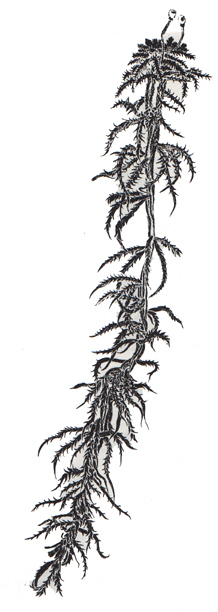

Sphagnum
Sphagnum species
(Sphagnopsida)
Description:
The genus Sphagnum is in a class by itself. Also
called peat moss or bog moss, sphagnum is usually wet and often grows in large
hummocks. Individual plants measure just 1/4 inch (7 mm.) long. The stem of
each plant is not forked. The branches at the tip of the stem crowd into a ball
called the capitulum, so that when you look down on the surface of the hummock
each individual plant appears as a circle. Down within the hummock, the side
branches of the individual plants are arranged in bunches called fascicles.
The leaves on the branches form spirals and press close to the branch. Stem leaves differ in size and shape. Colors vary from red, green, and yellow to brown.
Distribution:
Sphagnum follows the sedges in bog succession and creates
an acid environment in peat bogs, where it exerts an important effect on drainage,
erosion and permafrost.
Medicinal uses:
This soft, acidic plant absorbs moisture better than
a sponge. It is bactericidal, resistant to decay in herbaria, and safe to use
against skin.
Sphagnum was used extensively for surgical dressings during the first World War, and by mothers in Lapland and North America for infants' cradle linings, diapers, and toilet paper. (Crum, Oswalt) I have used it for my own infant and agree that it seems to prevent diaper rash.
Red sphagnum is good for a dressing on a bad cut or for sore eyes. (Lantis)
It can also be used for menstrual pads. (Kari) Sphagnums help to combat infection; sometimes they are boiled or warmed on hot rocks first, then applied to an infected place and covered with a bandage. If you have to put a splint on a broken bone, sphagnum is the best moss to use for padding.
Other uses:
Sphagnum is often used for chinking log cabin walls. Indians of Guatemala
believe the Christ Child was bedded in sphagnum.
Copyright © 1987 by Eleanor G. Viereck